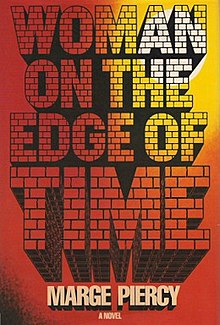Woman on the Edge of Time
 Cover of the Fawcett 1988 edition (paperback) | |
| Author | Marge Piercy |
|---|---|
| Language | English |
| Genre | Science fiction, Utopian fiction |
| Publisher | Alfred A. Knopf |
Publication date | 1976 |
| Publication place | United States |
| Media type | Print (Hardcover and Paperback) |
| Pages | 369 |
| ISBN | 0-394-49986-7 |
| OCLC | 2020128 |
| 813/.5/4 | |
| LC Class | PZ4.P618 Wo PS3566.I4 |
Woman on the Edge of Time (New York: Alfred A. Knopf, 1976) is a novel by Marge Piercy. It is considered a classic of utopian "speculative" science fiction as well as a feminist classic.
Plot summary
Thirty-seven-year-old Hispanic woman Consuelo (Connie) Ramos, recently released from forced detention in a mental institution for drug-fueled child abuse which led her to lose custody of her daughter, gets recommitted against her will. She was committed by her niece's pimp after she struck him because he was forcing her niece (Dolly) to have a dirty abortion. While committed and heavily drugged in a mental hospital in New York, she begins to communicate with a figure that may or may not be imaginary: an androgynous young woman named Luciente. Luciente is from the future, a utopian world in which a number of goals of the political and social agenda of the late sixties and early seventies radical movements have been fulfilled. Environmental pollution, homophobia, racism, phallogocentrism, class-subordination, consumerism, imperialism, and totalitarianism no longer exist in the agrarian, communal community of Mattapoisett. The death penalty, however, continues to exist ("We don't think it's right to kill ... . Only convenient."), as does war.
Connie learns that she is living at an important time in history, and she herself is in a pivotal position; her actions and decisions will determine the course of history. Luciente's utopia is only one possible future; a dystopian alternate future is a possibility—one in which a wealthy elite live on space platforms and subdue the majority of the population with psychotropic drugs and surgical control of moods, also harvesting these earth-bound humans' organs. Women are valued solely for their appearance and sexuality, and plastic surgery that gives women grotesquely exaggerated sexual features is commonplace.
The novel gives little indication as to whether or not Connie's visions are by-products of a mental disease or are meant to be taken literally, but ultimately, Connie's confrontation with the future inspires her to a violent action that will presumably prevent the dissemination of the mind-control technology that makes the future dystopia possible, since it puts an end to the mind-control experiments and prevents the lobotomy-like operation that had been planned for her. Though her actions do not ensure the existence of the Mattapoisett future, Connie nevertheless sees her act as a victory: "I'm a dead woman now too. ... But I did fight them. ... I tried."[1]
Publication history
- Piercy, Marge (1976). Woman on the Edge of Time. New York: Alfred A. Knopf. ISBN 0-394-49986-7.
- Piercy, Marge (1977). Woman on the Edge of Time. New York: Fawcett Crest. ISBN 0-449-23208-5.
- Piercy, Marge (1980). Woman on the Edge of Time. London: The Women's Press. ISBN 0-7043-3837-8.
- Piercy, Marge (1985). Woman on the Edge of Time. New York: Fawcett. ISBN 0-449-21082-0.
- Piercy, Marge (1987). Woman on the Edge of Time. London: The Women's Press. ISBN 0-7043-3837-8.
- Piercy, Marge (1987). Woman on the Edge of Time. New York: Fawcett. ISBN 0-449-21082-0.
- Piercy, Marge (1997). Woman on the Edge of Time. New York: Ballantine Books. ISBN 0-449-00094-X.
- Piercy, Marge (2000). Woman on the Edge of Time. London: The Women's Press. ISBN 0-7043-4656-7.
Reception
Early reviews called the novel absorbing and exciting and beautifully written, but also polemical and didactic. Piercy’s utopia was noted for “literally embodying every ideal of the counterculture/Movement: ecological wisdom, community, androgyny, ritual, respect for madness, propertylessness, etc.”[2] At the time, leaving the Sixties behind, American novels generally shared a post-apocalyptic feeling, asking “what are to be the new social and spiritual arrangements now that the old ones are completely shattered?”[3] In that context, Roger Sale, in the New York Times, found nothing new in Woman on the Edge of Time, calling the book imitative and derivative, and pointing out that “the major instruments … are terribly familiar pieces of apparatus, the mental hospital and a utopian community of the future.”[4]
References
- Notes
- ^ p. 375 of the Women's Press editions of 1979 and 1987.
- ^ "Woman on the Edge of Time by Marge Piercy". Kirkus Reviews. June 1, 1976.
{{cite journal}}: CS1 maint: date and year (link) - ^ Olderman, Raymond M. (1978). "American Fiction 1974-1976: The People Who Fell to Earth". Contemporary Literature. 19 (4): 497–530 – via JSTOR.
- ^ Sale, Roger (June 20, 1976). "Woman on the Edge of Time". New York Times. p. 189. Retrieved April 7, 2017.
{{cite news}}: Cite has empty unknown parameter:|dead-url=(help)
- Bibliography
- Lefanu, Sarah (1988). In the Chinks of the World Machine: Feminism and Science Fiction. London: The Women's Press. ISBN 0-7043-4092-5.
- Lefanu, Sarah (1989). Feminism and Science Fiction. Bloomington, IN: Indiana University Press. ISBN 0-253-23100-0. (U.S. variant title of preceding)
